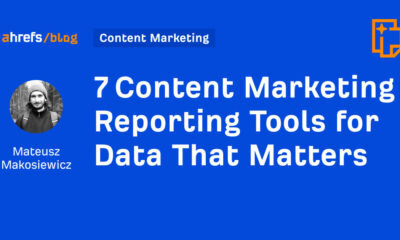SEO
How To Harness First-Party Data & Win In A Cookieless Future
How prepared is your organization for the imminent loss of third-party data?
Are you ready for first-party data to take center stage in your marketing strategy?
Maybe you’re feeling unsure of how to use first-party data?
While cookies going away will reduce your access to third-party data, you can still strike the right balance with your acquisition strategies and provide your customers with high-converting, personalized experiences.
On April 27, I moderated a webinar with Vishal Maru, Vice President of Digital Solutions at iQuanti. He explained how enterprises could embrace the power of first-party data and better connect with their customers.
Here is a summary of the webinar. To access the entire presentation, complete the form.
How Advertisers Will Be Affected
The changing privacy landscape has a dramatic impact on the digital marketing ecosystem and is caused by:
- A change in customer mindset.
- Privacy regulations, such as GDPR, CCPA, etc.
- Privacy changes from key players, such as Google & Apple.
[See the full impact of privacy changes] Instantly access the webinar →
What This Means For Advertisers
The reduction and removal of third-party data has the potential to cause:
- Ineffective targeting.
- Challenges with measurement & attribution.
- An inability to track reach and frequency.
These all lead to lower campaign efficiencies, lower advertising ROI, and scale limits.
Why First-Party Data?
First-party data is the only sure solution during these uncertain privacy changes, in terms of:
- Accuracy.
- Relevancy.
- Availability.
- Cost-effectiveness.
[Learn how first-party data can still provide incredible value] Instantly access the webinar →
How To Leverage First-Party Data Effectively
The great news is that first-party data already exists within your organization and marketing database.
The key is understanding how to locate, use, and implement your owned data:
- Segment.
- Actively increase ways to build first-party data.
- Optimize for profitability.
- Create partnerships to leverage second-party data.
- Personalize.
- Gather consent.
Key Components For Building A Strong First-Party Data Strategy
- Build a robust first-party data and MarTech infrastructure.
- Effectively leverage first-party data for digital activation.
- Effectively leverage first-party data for measurement and attribution.
[Learn exactly how publishers & retail segments are doing this] Instantly access the webinar →
How To Build A Roadmap For Implementation
Organizations face challenges with effectively leveraging first-party data for digital marketing.
These challenges are:
- Organizational & data silos.
- Lack of in-house capabilities.
- Lack of effective full-funnel activation strategy.
Steps To Overcoming Challenges & Building A Roadmap
Step 1: Build a first-party data strategy.
- Break organizational and data silos.
- Come together to build a first-party data strategy (including identifying all data sources, data cleaning, mapping across the customer journey, and opportunities for building data).
Step 2: Invest in a robust infrastructure.
- Use onboarding platforms – CDP, CMP, ID Resolution, personalization, GMP, etc.
- Build a connected infrastructure.
Step 3: Build or augment capabilities.
- Utilize data science, advanced analytics, and platform-specific (CDP, personalization, etc.) capabilities.
- Augment resources.
Step 4: Activate first-party data effectively.
- Segment for prioritization & personalization.
- Take a full-funnel approach.
- Leverage AI/ML for an advanced strategy (for example, predictive audiences).
[Find out how to get a first-party data self-assessment] Instantly access the webinar →
[Slides] How To Harness First-Party Data & Win In A Cookieless Future
Here’s the presentation:
How To Harness First-Party Data & Win In A Cookieless Future from Search Engine Journal
Join Us For Our Next Webinar!
SERP Trends & Top Keyword Data By Industry
Which search trends and keywords should be a focus for your business this year?
Get insight into a variety of SEO metrics across regions, more specifically in the US and UK, which can help you make more data-driven decisions. Join our next webinar on May 4 at 2 p.m. ET.
Image Credits
Featured Image: Paulo Bobita/Search Engine Journal
!function(f,b,e,v,n,t,s)
{if(f.fbq)return;n=f.fbq=function(){n.callMethod?
n.callMethod.apply(n,arguments):n.queue.push(arguments)};
if(!f._fbq)f._fbq=n;n.push=n;n.loaded=!0;n.version=’2.0′;
n.queue=[];t=b.createElement(e);t.async=!0;
t.src=v;s=b.getElementsByTagName(e)[0];
s.parentNode.insertBefore(t,s)}(window,document,’script’,
‘https://connect.facebook.net/en_US/fbevents.js’);
if( typeof sopp !== “undefined” && sopp === ‘yes’ ){
fbq(‘dataProcessingOptions’, [‘LDU’], 1, 1000);
}else{
fbq(‘dataProcessingOptions’, []);
}
fbq(‘init’, ‘1321385257908563’);
fbq(‘track’, ‘PageView’);
fbq(‘trackSingle’, ‘1321385257908563’, ‘ViewContent’, {
content_name: ‘first-party-data-cookieless-recap’,
content_category: ‘paid-media pay-per-click seo webinar ‘
});
SEO
Google Declares It The “Gemini Era” As Revenue Grows 15%

Alphabet Inc., Google’s parent company, announced its first quarter 2024 financial results today.
While Google reported double-digit growth in key revenue areas, the focus was on its AI developments, dubbed the “Gemini era” by CEO Sundar Pichai.
The Numbers: 15% Revenue Growth, Operating Margins Expand
Alphabet reported Q1 revenues of $80.5 billion, a 15% increase year-over-year, exceeding Wall Street’s projections.
Net income was $23.7 billion, with diluted earnings per share of $1.89. Operating margins expanded to 32%, up from 25% in the prior year.
Ruth Porat, Alphabet’s President and CFO, stated:
“Our strong financial results reflect revenue strength across the company and ongoing efforts to durably reengineer our cost base.”
Google’s core advertising units, such as Search and YouTube, drove growth. Google advertising revenues hit $61.7 billion for the quarter.
The Cloud division also maintained momentum, with revenues of $9.6 billion, up 28% year-over-year.
Pichai highlighted that YouTube and Cloud are expected to exit 2024 at a combined $100 billion annual revenue run rate.
Generative AI Integration in Search
Google experimented with AI-powered features in Search Labs before recently introducing AI overviews into the main search results page.
Regarding the gradual rollout, Pichai states:
“We are being measured in how we do this, focusing on areas where gen AI can improve the Search experience, while also prioritizing traffic to websites and merchants.”
Pichai reports that Google’s generative AI features have answered over a billion queries already:
“We’ve already served billions of queries with our generative AI features. It’s enabling people to access new information, to ask questions in new ways, and to ask more complex questions.”
Google reports increased Search usage and user satisfaction among those interacting with the new AI overview results.
The company also highlighted its “Circle to Search” feature on Android, which allows users to circle objects on their screen or in videos to get instant AI-powered answers via Google Lens.
Reorganizing For The “Gemini Era”
As part of the AI roadmap, Alphabet is consolidating all teams building AI models under the Google DeepMind umbrella.
Pichai revealed that, through hardware and software improvements, the company has reduced machine costs associated with its generative AI search results by 80% over the past year.
He states:
“Our data centers are some of the most high-performing, secure, reliable and efficient in the world. We’ve developed new AI models and algorithms that are more than one hundred times more efficient than they were 18 months ago.
How Will Google Make Money With AI?
Alphabet sees opportunities to monetize AI through its advertising products, Cloud offerings, and subscription services.
Google is integrating Gemini into ad products like Performance Max. The company’s Cloud division is bringing “the best of Google AI” to enterprise customers worldwide.
Google One, the company’s subscription service, surpassed 100 million paid subscribers in Q1 and introduced a new premium plan featuring advanced generative AI capabilities powered by Gemini models.
Future Outlook
Pichai outlined six key advantages positioning Alphabet to lead the “next wave of AI innovation”:
- Research leadership in AI breakthroughs like the multimodal Gemini model
- Robust AI infrastructure and custom TPU chips
- Integrating generative AI into Search to enhance the user experience
- A global product footprint reaching billions
- Streamlined teams and improved execution velocity
- Multiple revenue streams to monetize AI through advertising and cloud
With upcoming events like Google I/O and Google Marketing Live, the company is expected to share further updates on its AI initiatives and product roadmap.
Featured Image: Sergei Elagin/Shutterstock
SEO
brightonSEO Live Blog

Hello everyone. It’s April again, so I’m back in Brighton for another two days of Being the introvert I am, my idea of fun isn’t hanging around our booth all day explaining we’ve run out of t-shirts (seriously, you need to be fast if you want swag!). So I decided to do something useful and live-blog the event instead.
Follow below for talk takeaways and (very) mildly humorous commentary. sun, sea, and SEO!
SEO
Google Further Postpones Third-Party Cookie Deprecation In Chrome

Google has again delayed its plan to phase out third-party cookies in the Chrome web browser. The latest postponement comes after ongoing challenges in reconciling feedback from industry stakeholders and regulators.
The announcement was made in Google and the UK’s Competition and Markets Authority (CMA) joint quarterly report on the Privacy Sandbox initiative, scheduled for release on April 26.
Chrome’s Third-Party Cookie Phaseout Pushed To 2025
Google states it “will not complete third-party cookie deprecation during the second half of Q4” this year as planned.
Instead, the tech giant aims to begin deprecating third-party cookies in Chrome “starting early next year,” assuming an agreement can be reached with the CMA and the UK’s Information Commissioner’s Office (ICO).
The statement reads:
“We recognize that there are ongoing challenges related to reconciling divergent feedback from the industry, regulators and developers, and will continue to engage closely with the entire ecosystem. It’s also critical that the CMA has sufficient time to review all evidence, including results from industry tests, which the CMA has asked market participants to provide by the end of June.”
Continued Engagement With Regulators
Google reiterated its commitment to “engaging closely with the CMA and ICO” throughout the process and hopes to conclude discussions this year.
This marks the third delay to Google’s plan to deprecate third-party cookies, initially aiming for a Q3 2023 phaseout before pushing it back to late 2024.
The postponements reflect the challenges in transitioning away from cross-site user tracking while balancing privacy and advertiser interests.
Transition Period & Impact
In January, Chrome began restricting third-party cookie access for 1% of users globally. This percentage was expected to gradually increase until 100% of users were covered by Q3 2024.
However, the latest delay gives websites and services more time to migrate away from third-party cookie dependencies through Google’s limited “deprecation trials” program.
The trials offer temporary cookie access extensions until December 27, 2024, for non-advertising use cases that can demonstrate direct user impact and functional breakage.
While easing the transition, the trials have strict eligibility rules. Advertising-related services are ineligible, and origins matching known ad-related domains are rejected.
Google states the program aims to address functional issues rather than relieve general data collection inconveniences.
Publisher & Advertiser Implications
The repeated delays highlight the potential disruption for digital publishers and advertisers relying on third-party cookie tracking.
Industry groups have raised concerns that restricting cross-site tracking could push websites toward more opaque privacy-invasive practices.
However, privacy advocates view the phaseout as crucial in preventing covert user profiling across the web.
With the latest postponement, all parties have more time to prepare for the eventual loss of third-party cookies and adopt Google’s proposed Privacy Sandbox APIs as replacements.
Featured Image: Novikov Aleksey/Shutterstock
-
SEARCHENGINES6 days ago
Daily Search Forum Recap: April 19, 2024
-

 WORDPRESS7 days ago
WORDPRESS7 days agoHow to Make $5000 of Passive Income Every Month in WordPress
-

 WORDPRESS6 days ago
WORDPRESS6 days ago13 Best HubSpot Alternatives for 2024 (Free + Paid)
-

 MARKETING6 days ago
MARKETING6 days agoBattling for Attention in the 2024 Election Year Media Frenzy
-

 WORDPRESS6 days ago
WORDPRESS6 days ago7 Best WooCommerce Points and Rewards Plugins (Free & Paid)
-

 AFFILIATE MARKETING7 days ago
AFFILIATE MARKETING7 days agoAI Will Transform the Workplace. Here’s How HR Can Prepare for It.
-

 SEO6 days ago
SEO6 days agoGoogle Answers Whether Having Two Sites Affects Rankings
-

 MARKETING5 days ago
MARKETING5 days agoAdvertising in local markets: A playbook for success
















You must be logged in to post a comment Login